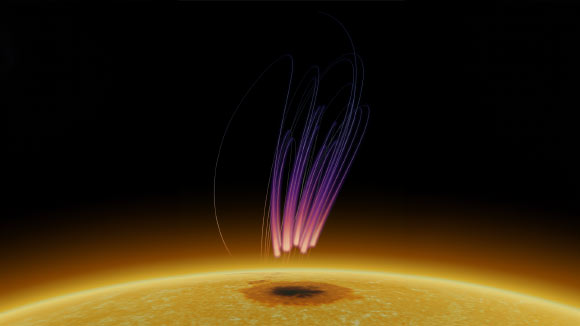Astronomers using the Karl G. Jansky Very Large Array have observed long-lasting aurora-like radio bursts above a sunspot. This discovery could help us better understand our own star as well as the behavior of distant stars that produce similar radio emissions.
Yu et al. discovered radio bursts above a sunspot that resemble radio emissions from aurorae on Earth. The pink-purple streaks in this illustration represent the radio emissions, with higher-frequency radio signals in pink, closer to the sunspot, and lower frequencies in purple. The thin lines represent magnetic field lines above the sunspot. The sunspot is the dark region on the Sun at the bottom. Image credit: Sijie Yu, New Jersey Institute of Technology.
“This sunspot radio emission represents the first detection of its kind,” said Dr. Sijie Yu, an astronomer at the New Jersey Institute of Technology.
“Detected about 40,000 km (25,000 miles) above a sunspot — a relatively cool, dark, and magnetically active region on the Sun — such radio bursts had previously been observed only on planets and other stars.”
On Earth, and other planets such as Jupiter and Saturn, aurorae shimmer in the night sky when solar particles are caught up in the planet’s magnetic field and get pulled toward the poles, where magnetic field lines converge.
As they accelerate poleward, the particles generate intense radio emissions at frequencies around a few hundred kilohertz and then smash into atoms in the atmosphere, causing them to emit light as aurorae.
The team’s analysis suggests the radio bursts above the sunspot are likely produced in a comparable way — when energetic electrons get trapped and accelerated by converging magnetic fields above a sunspot.
Unlike Earth’s aurorae, though, the radio bursts from sunspots occur at much higher frequencies — hundreds of thousands of kilohertz to roughly 1 million kilohertz.
“That’s a direct result of the sunspot’s magnetic field being thousands of times stronger than Earth’s,” Dr. Yu said.
Similar radio emissions have previously been observed from some types of low-mass stars as well.
This discovery introduces the possibility that aurora-like radio emissions may originate from large spots on those stars in addition to the previously proposed aurorae in their polar regions.
“The discovery excites us as it challenges existing notions of solar radio phenomena and opens new avenues for exploring magnetic activities both in our Sun and in distant stellar systems,” Dr. Yu said.
“NASA’s growing heliophysics fleet is well suited to continue to investigate the source regions of these radio bursts,” said Dr. Natchimuthuk Gopalswamy, a heliophysicist and solar radio researcher at NASA’s Goddard Space Flight Center.
“For example, the Solar Dynamics Observatory continually monitors the Sun’s active regions, which likely give rise to this phenomenon.”
In the meantime, the authors plan to reexamine other solar radio bursts to see whether any appear to be similar to the aurora-like radio bursts they found.
“We aim to determine if some of the previously recorded solar bursts could be instances of this newly identified emission,” Dr. Yu said.
The findings appear in the journal Nature Astronomy.
_____
S. Yu et al. 2024. Detection of long-lasting aurora-like radio emission above a sunspot. Nat Astron 8, 50-59; doi: 10.1038/s41550-023-02122-6


